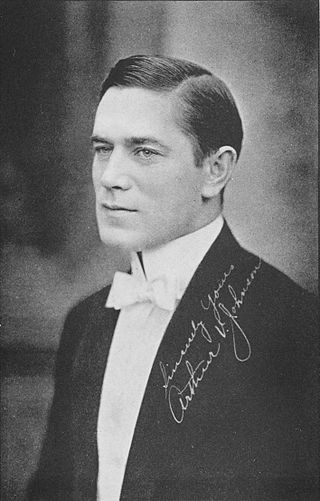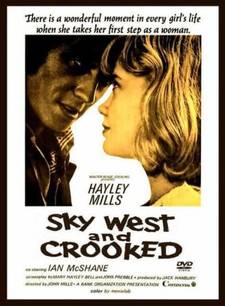Related Research Articles

Arthur Vaughan Johnson was a pioneer actor and director of the early American silent film era, and uncle of Olympic wrestler and film actor Nat Pendleton.
Joseph Graybill was an American silent film actor. He appeared in several films directed by D.W. Griffith.

Linda Arvidson was an American stage and film actress. She became one of America's early motion picture stars while working at Biograph Studios in New York, where none of the company's actors, until 1913, were credited on screen. Along with Florence Lawrence, Marion Leonard, and other female performers there, she was often referred to by theatergoers and in trade publications as simply one of the "Biograph girls". Arvidson began working in the new, rapidly expanding film industry after meeting her future husband D. W. Griffith, who impressed her as an innovative screen director. Their marriage was kept secret for reasons of professional discretion.

Sky West and Crooked is a 1966 British romantic drama film starring Hayley Mills. The film was directed by her father, John Mills, and was co-written by her mother, Mary Hayley Bell.
What the Daisy Said is a one-reel film made by D. W. Griffith for Biograph in 1910.
After Many Years is a 1908 American silent drama film directed by D. W. Griffith. Prints of the film exist in the Library of Congress film archive. The film is an adaptation of Enoch Arden.

Ramona is a 1910 American short drama film directed by D. W. Griffith, based on Helen Hunt Jackson's 1884 novel Ramona. Through a love story, the early silent short explores racial injustice to Native Americans and stars Mary Pickford and Henry B. Walthall. A copy of the print survives in the Library of Congress film archive. The film was remade in 1928 with Dolores del Río and 1936 with Loretta Young.
These are the films directed by the pioneering American filmmaker D. W. Griffith (1875–1948). According to IMDb, he directed 518 films between 1908 and 1931.

The Last Drop of Water is a 1911 American short silent Western film directed by D. W. Griffith and starring Blanche Sweet. Three known prints of the film survive. It was filmed in the San Fernando desert as well as Lookout Mountain, California. The film was considered the "most ambitious film made by Griffith during the California trip of 1911" before the Biograph company moved back to New York. It was filmed on or between the 14 May and May 20, 1911. It was reissued by Biograph August 13, 1915.

Gladys Egan was an early 20th-century American child actress, who between 1907 and 1914 performed professionally in theatre productions as well as in scores of silent films. She began her brief entertainment career appearing on the New York stage as well as in plays presented across the country by traveling companies. By 1908 she also started working in the film industry, where for six years she acted almost exclusively in motion pictures for the Biograph Company of New York. The vast majority of her screen roles during that period were in shorts directed by D. W. Griffith, who cast her in over 90 of his releases. While most of Egan's films were produced by Biograph, she did work for other motion-picture companies between 1911 and 1914, such as the Reliance Film Company and Independent Moving Pictures. By 1916, Egan's acting career appears to have ended, and she no longer was being mentioned in major trade journals or included in published studio personnel directories as a regularly employed actor. Although she may have performed as an extra or in some bit parts after 1914, no available filmographies or entertainment publications from the period cite Egan in any screen or stage role after that year.

Rescued by Rover is a 1905 British short silent drama film, directed by Lewin Fitzhamon, about a dog who leads its master to his kidnapped baby, which was the first to feature the Hepworth's family dog Blair in a starring role; following the release, the dog became a household name and he is considered to be the first dog film star. The film, which according to Michael Brooke of BFI Screenonline, "marks a key stage in the medium's development from an amusing novelty to the seventh art," and, "possibly the only point in film history when British cinema unquestionably led the world," was an advance in filming techniques, editing, production and story telling.
The Fight for Freedom is a 1908 American black-and-white short silent Western film which may have been directed by D. W. Griffith. Filmed in Shadyside, New Jersey in June 1908, the film was released on July 17, 1908.

Eliška "Elsie" Paroubek was an American girl who was a victim of kidnapping and murder in the spring of 1911. Her disappearance and the subsequent search for her preoccupied Illinois, Wisconsin, and Minnesota law enforcement for six weeks. Her funeral was attended by between 2,000 and 3,000 people.
The Greaser's Gauntlet is a 1908 American silent short adventure film directed by D. W. Griffith. It was released by the Biograph Company and copyrighted on August 6, 1908. The film introduced the first extended use of parallel editing in Griffith's work.
The Red Girl is a 1908 American black-and-white short silent Western film directed by D. W. Griffith for the American Mutoscope & Biograph Company. It stars Florence Lawrence and the cast includes Charles Inslee, George Gebhardt, D. W. Griffith, Mack Sennett and Linda Arvidson.

Ingomar, the Barbarian is a 1908 American silent short drama film directed by D. W. Griffith. It has been placed in the same genre as the theatrical toga play. It is based on the play Der Sohn der Wildnis by Friedrich Halm, translated by Maria Ann Lovell as Ingomar, the Barbarian.

An Awful Moment is a 1908 American silent short drama film directed by D. W. Griffith. A print of the "one-reeler" is preserved in the film archive of the Library of Congress.

The Child Stealers also known as The Kidnapped Child or Child Stealing is a 1904 British silent crime film about kidnapping, directed by William Barker and produced by the Warwick Trading Company.

A Sound Sleeper is a 1909 American comedy film directed by D. W. Griffith and produced by the American Mutoscope and Biograph Company. The short was filmed in one day in the Coytesville borough of Fort Lee, New Jersey, which at the time was a popular filming location for many early motion-picture studios in the northeastern United States. Due to the brief running time of this comedy, it was originally distributed in April 1909 on a split reel with another Biograph release, a longer dramatic film titled The Winning Coat.

The Road to the Heart is a 1909 American short film, a dramedy directed by D. W. Griffith and produced by the Biograph Company of New York City. Starring David Miles, Anita Hendrie and Herbert Yost, the production was filmed in two days in March 1909 at Biograph's studio in Manhattan. It was released in April that year and distributed to theaters on a "split-reel", which was a single film reel that included more than one motion picture. The other picture that accompanied this comedy was the Biograph comedy Trying to Get Arrested.
References
- ↑ "Progressive Silent Film List: The Adventures of Dollie". Silent Era. Retrieved April 3, 2008.
- ↑ Ramsaye, Terry (1926). A Million and One Nights: A History of the Motion Picture. Vol. 2. New York City: Simon and Schuster. pp. 456–458.